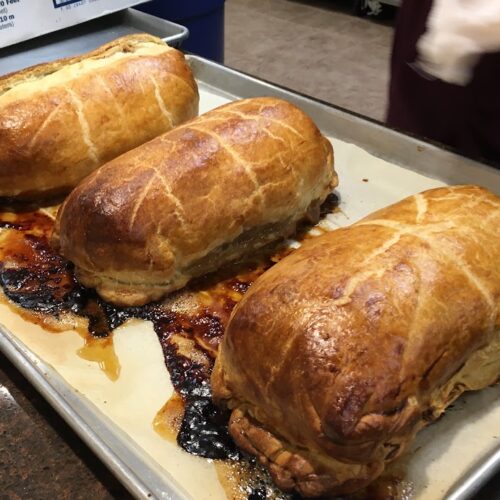
Beef Wellington
Beef Wellington recipe including Duxelles recipe.
Ingredients
Beef Wellington
- 3 lbs Center Cut Tenderloin
- 1 tbsp Olive Oil
- Salt and Pepper Enough to generously coat the fillet
- 2 cups Duxelles
- 12 Slices of Prosciutto
- 2 tbsp Dijon
- 2 Puff Pastry Sheets
- 2 Lightly Beaten Eggs
- 1/2 teaspoon Salt To season puff pastry
Duxelles
- 1.5 lbs Button Mushrooms
- 2 Shallots
- 4 Cloves of Garlic
- 2 Sprigs of Thyme Leaves only
- 2 tbsp Salted Butter
- 2 tbsp Olive Oil
- Salt and Black Pepper Season to taste
Instructions
Beef Wellington
- Remove tenderloin from the refrigerator and allow to sit out for an hour before cooking.
- Preheat Oven to 425 degrees.
- Season your tenderloin with salt and pepper.
- Heat a large sauté pan over high heat. Once the pan is very hot; add the olive oil. Sear the tenderloin, in the hot oil, on all sides and on the ends. Remove from the pan and set aside.
- Brush the tenderloin with Dijon mustard.
- Lay out a long sheet of plastic wrap, lay down slices of prosciutto in a rectangle. Try to shingle them so they will completely wrap around the tenderloin. Spread your Duxelles across the prosciutto all the way to each edge.
- Lay the tenderloin, on one of the long edges, on top of the Duxelles. Carefully pull up one edge of the plastic wrap, allowing the tenderloin to, slowly, roll and be wrapped by the prosciutto and Duxelles. Once completely wrapped, roll and seal the edges of the plastic wrap. Place the tenderloin in the refrigerator for thirty minutes.
- Lay your puff pastry sheets out and press them together, making one large sheet. Remove the tenderloin from the refrigerator and unwrap from the plastic wrap. Lay the tenderloin on the long edge of the puff pastry; tightly roll it. If there is an excessive amount of pastry, trim it so that it doesn’t overlap too much. Tuck the sides of the puff pastry underneath so there are no openings.
- Lightly sprinkle the top of the pastry with salt then brush the egg wash the top and sides of the puff pastry.
- Place in the oven at 425 degrees for 20 minutes, reduce the heat to 400 degrees then cook for another 30 minutes or until the internal temperature is between 125-130 degrees. Let rest 15 minutes before slicing with a serrated knife. Be careful when slicing, do your best to keep the puff pastry from breaking away from the roast.
Duxelles
- Add mushrooms, shallots, garlic, and thyme to a food processor and pulse until all ingredients are finely chopped. (If you don’t have a food processor just chop everything very small)
- Heat a sauté pan over medium heat. Add butter and olive oil to the pan and allow the butter to melt. Add the mushroom mixture to the pan and let cook until all liquid from the mushrooms has evaporated. This will take some time, be patient, it is essential that the Duxelles is dry.
- Season with salt and pepper.